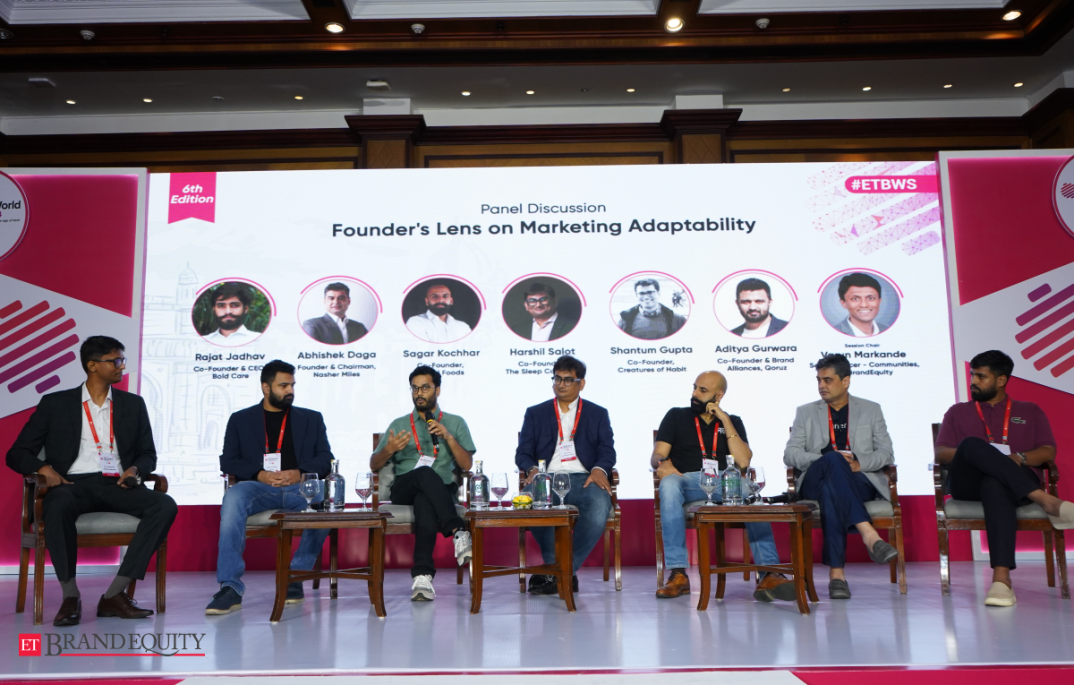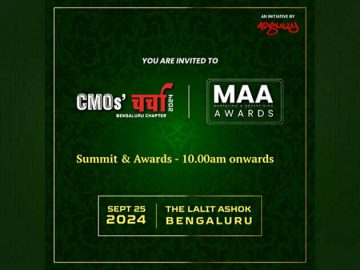There’s a lot to learn from D2C brand-builders. As challenger brands, these businesses have challenged the status quo across product, marketing, and customer experience to survive and thrive. These brands are owning the customer relationship in a way that’s never been seen before.
At Brand World Summit 2024, organised by ETBrandEquity.com, founders of D2C brands joined a panel discussion on surviving multiple market cycles and the importance of building an adaptable marketing organisation.
The session was joined by Rajat Jadhav, Co-Founder & CEO, Bold Care; Abhishek Daga, Founder & Chairman, Nasher Miles; Sagar Kochhar, Co-Founder, Rebel Foods; Harshil Salot, Co-Founder, The Sleep Company; Shantum Gupta, Co-Founder, Creatures of Habit; Aditya Gurwara, Co-Founder & Brand Alliances, Qoruz and chaired by Varun Markande, ETBrandEquity.
Most, if not all, D2C brands have a raison d’être. They have identified unaddressed consumer needs, created new categories, and elevated the quality of product, service, and engagement.
Gupta remarked, “At Creatures of Habit, our customer relationships are very personal. That’s the reason why we started off because we found the fashion category to be very distant. We wanted to bridge that gap because that’s what D2C allows you to do. For us, it boils down to customers being able to reach out and talk to the brand and not feel like they’re buying from a faceless corporate. Giving that sense of personal identification to the customers has always been important to us.”
Similarly, another D2C brand, The Sleep Company, redefined consumer engagement with the mattress category by linking it to wellness.
Salot observed, “Mattress as a category sounded very boring a few years ago, but we’ve seen that the customer has evolved, especially post-COVID. There’s a lot more focus on health and since sleep is a part of health and well-being, mattresses are a derivative of that. So we built our positioning almost as a wellness product. Today, we see a lot of questions coming to our customer care on how mattresses impact sleep because with the current lifestyle, most people in their 40s have some kind of back or shoulder issue.”
By addressing niche consumer pain points, some D2C brands have inadvertently tapped into potentially large addressable markets.
Kochhar shared, “When we started Faasos, the intent was to build the single largest homegrown QSR brand in a market dominated by global QSR chains. Soon we realised the challenges within the ecosystem and thought, how do you solve these frictional forces? In 2014, we moved away from the offline format and pioneered the cloud kitchen service model.”
Post-2016, Rebel Foods became a multi-brand cloud kitchen business with many differentiated brands, including Behrouz Biryani, The Sweet Truth, Oven Story, and Wendy’s.
Kochhar added, “One thing common across our brands is that their recipe for success is the purpose of existence. Behrouz Biryani’s aspiration is to be the biryani brand for group outings and celebratory occasions. As a D2C brand, you have to ensure the brand is positioned appropriately, including the way it is delivered, nomenclature, etc.”
The rise of D2C brands has been supported by e-commerce marketplaces, which have shifted some of the burden of marketing so that founders can focus on the core business.
Daga remarked, “The baggage category is a functional category, and that’s why we entered this space. There were only three big players in the country who had 30-35% of the market. The rest of the market was unbranded, and there was a huge opportunity for someone to enter.”
He added, “The products in this segment came in the same boring colours and designs, so we differentiated with our variety of product colours and designs. At the nascent stage, we launched on marketplaces like Amazon and Flipkart using performance marketing to scale. Today, we’re using top-of-the-funnel marketing activities and have signed Rishabh Pant as a brand ambassador.”
At what point does a D2C brand shift from performance marketing to brand marketing to scale growth?
Jadhav shared, “There have never been organised players in the men’s sexual wellness category even though the TAM is close to ~90 million men in the country. We realised there’s a supply-demand mismatch and entered the category as a fundamentally online player.”
He added, “Online is not a force fit in this category as customers prefer solutions online because of its privacy orientation.”
Much like Nasher Miles, Bold Care started out with performance marketing to scale the business. Since there were virtually no competitors, the brand was able to experiment and get the product market fit right. It experimented with the product, price point, and distribution until its ratings and market share on marketplaces started improving.
Jadhav stated, “If you see the marketing that we’ve done in the last six odd months, it’s a lot more top-of-the-funnel focused. The first three years of the business were performance-oriented, and the last six months with Ranveer Singh coming on board as an investor and owner, we’ve transitioned from being performance-oriented to brand marketing becoming a big part of budgets.”
He added, “Once you reach the stage where product-market fit is there, then it is high time you shift from being performance-oriented to a slightly blended CAC approach. So you’re not looking to get revenue today but generate it for the next three months. If you do brand marketing too early as a D2C brand, when your distribution is not set, demand is not there, and people don’t know where to look for your products, then it won’t work out.”
Influencer marketing has transformed the fortunes of many D2C brands, enabling them to come across as more authentic to consumers.
Gurwara remarked, “Influencers are important, but for D2C brands, which stage do you bring them in? If you do it too early, it will be kind of a waste. If you do it too late, it might not affect your growth enough.”
Adding further, he said, “There are various funnels where influencers can be used, and the most innovative use has been from D2C brands versus brands with larger pockets. At the end of the day, an influencer is just a creator, but I’ve seen more than enough D2C brands leverage influencers not for the influence they wield but the content they generate. The same content impacts the performance metrics.”
Gurwara explained, “For D2C brands, leveraging influencer marketing is more about the spread of influencers and how you leverage creator content. First, you make decent content with a creator in a mid-micro level category but use multiple different creators to fuel your performance marketing. Then you mix influencers into the ecosystem versus just at the top of the funnel.”
“The objective matters, and if D2C brands solely use influencer marketing to drive sales, then it doesn’t work very often,” concluded Gurwara.
The session ended with D2C brands sharing their playbook for growth, learnings from building a business from scratch, and marketing strategies for different stages of the brand lifecycle.
At the 6th edition of Brand World Summit 2024, organised by ETBrandEquity.com, Sanjiv Mehta, executive chairman of L Catterton India and Sudhir Sitapati, managing director and chief executive officer of Godrej Consumer Products discussed the importance of embracing technology in marketing, highlighting the potential of new technologies to enhance marketing strategies.
- Published On Jul 13, 2024 at 08:27 AM IST
Join the community of 2M+ industry professionals
Subscribe to our newsletter to get latest insights & analysis.
Download ETBrandEquity App
- Get Realtime updates
- Save your favourite articles
![]()
![]()
Scan to download App





